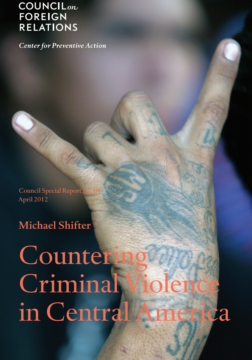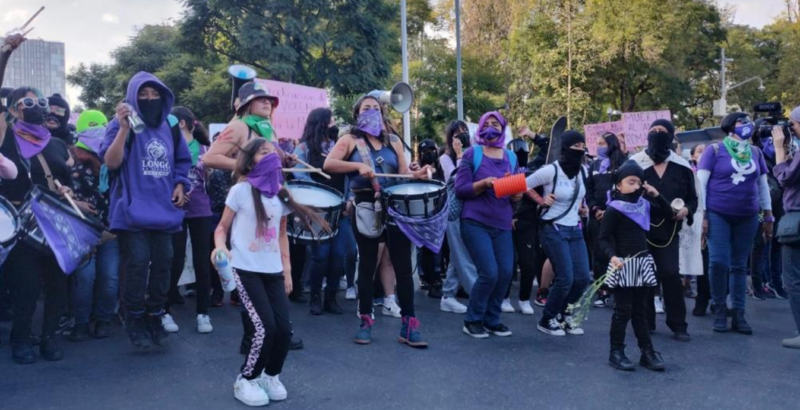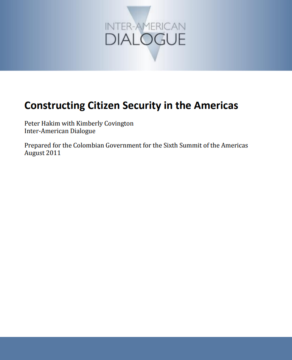
Countering Criminal Violence in Central America
Violent crime in Central America, particularly in the “northern triangle,” is reaching breathtaking levels.
A Daily Publication of The Dialogue
Women across Latin America, from Mexico City to Buenos Aires, took to the streets on Nov. 25 to mark the International Day for the Elimination of Violence against Women, demanding greater action from authorities. Latin America has among the highest rates of gender-based violence in the world, according to the Wilson Center, and many of the perpetrators are never brought to justice. Honduras suffers from the highest rates in the region, followed by the Dominican Republic and El Salvador. What accounts for the elevated rates of gender-based violence in Latin America and the Caribbean? What progress has been made in tackling femicide in the region, and what further steps should be taken toward combating the problem?
Caroline Beer, John G. McCullough Professor of Political Science at the University of Vermont: “Latin America stands out as the region with both the highest rates of gender-based violence and the highest rates of women in positions of political power. The relationship between women’s autonomy and gender-based violence sometimes follows an upside-down U-curve. With low levels of women’s autonomy, rates of violence are moderate. As women gain greater access to education, income and political influence, backlash to women’s growing equality may include violence. Thus, at low levels of women’s equality, greater autonomy may actually lead to greater violence. But at a certain point, as women gain even more influence, rates of violence will go down. There is reason to believe that many countries in Latin America are near the top of the U-curve. The solution is to further increase women’s access to education, income and political influence, to push beyond the top of the upside-down U-curve. Important progress has been made. Women’s activism and widespread protests have drawn the public’s attention to the crisis of gender-based violence. The naming of certain types of female homicide as ‘femicide’ is an important indicator of progress, drawing attention to the unique horrors of sexual violence and violence suffered at the hands of intimate partners. To further address the crisis, judicial institutions need to be strengthened and police and prosecutors need incentives to take gender-based violence seriously. Specialized offices with investigators, prosecutors and social workers specifically trained to support victims of gender-based violence and prosecute perpetrators are an important step forward.”
Valeria Durán, investigative reporter at Mexicanos Contra la Corrupción y la Impunidad: “One of the main problems causing the high rates of gender-based violence in Latin America and the Caribbean is the inability of the authorities and the state to safeguard women’s safety. In Mexico, significant progress has been made with the recognition at the national level of the rate of femicide within the federal criminal code and the state criminal codes. It homologizes how a homicide is legally different from a femicide, but underreporting remains latent. Much work is still needed within justice institutions to investigate crimes through a gendered lens, and not render invisible women who are murdered in extremely violent manners in Mexico. The situation is repeated across Latin America. One example is Venezuela, where in 2016 the regime decided to stop counting femicides. It is not known what activities it has carried out, or what the budget is for its flagship program, Mama Rosa, which promised to eradicate gender-based violence in the country. The Ciudad Mujer program in El Salvador, emblematic at the time, reduced the budget, dismissed staff and reduced their care under the government of Nayib Bukele. In Bolivia, more than 40 percent of funds earmarked for the prevention of gender-based violence and the care of victims has not been implemented. In Brazil, the Jair Bolsonaro administration has been reducing the budget of the Ministry of Women, Family and Human Rights year after year. In 2022 it reached its lowest point. Unfortunately, rather than progress, what has permeated is a setback in public policies to eradicate gender-based violence, which could explain why the death rates are still on the rise.”
Lorraine Bayard de Volo, professor in the Department of Women and Gender Studies at the University of Colorado Boulder: “Although femicides occur worldwide, a complex causal web contributes to the particularly high rates in Latin America and the Caribbean. Proximate causes include narco-violence, corruption and misogyny, sustained over time by neoliberalism, neo-imperialism, and colonialism. The dangers fall particularly hard on poor women who are racial or ethnic minorities—women who have little power in society and whose unsolved murders come at little cost to local authorities. Tens of thousands of women throughout Latin America have mobilized against mass impunity for gender-based crimes. Before this year’s street protests on the International Day for the Elimination of Violence against Women, there was Mexico City activists’ glitter bombs and Chilean feminists’ viral ‘Un violador en tu camino’ mass performance, both in 2019. Nearly two decades prior, small groups of women painted black crosses on pink backgrounds throughout Ciudad Juárez to raise awareness about femicides. These collective efforts are beginning to produce results, as authorities are less able to ignore or deny femicide. In combating the problem, governments should prioritize funding for prevention and for services to survivors, along with ending impunity for such crimes. Better data gathering would allow for a more detailed understanding of the causes of femicide and more effective means of prevention. Finally, asylum is a human right, and women and LGBTQ people must be able to seek asylum in the United States and elsewhere when they have a well-founded fear of persecution on the basis of gender, gender identity or sexuality.”
Caridad Araujo, chief of the Gender and Diversity Division at the Inter-American Development Bank: “Gender-based violence is a product of multiple factors. The first type of factor is structural. This includes individual characteristics such as level of education, parenting or decision-making capacity, but also factors related to relationships, such as early marriage and number of pregnancies. Other structural factors are related to social context, like the household financial situation, and the characteristics of the community, like social norms or gaps in infrastructure. These types of causes interact with circumstantial triggers–one very good example of this is alcohol consumption, which has proven to increase the level of intimate partner violence by four to seven times, as the evidence Latin America and the Caribbean suggests. In our region, structural factors exist as a result of pre-existing inequities, so we can say the odds are given for this type of violence to happen when they meet trigger situations. I’m not sure we can still talk about progress in the region in terms of tackling femicide, but there is definitely a lot more awareness about the issue. Challenges remain in multiple dimensions, including generating better data to tackle the problem and assess progress (or lack thereof). One encouraging step is that more citizens are demanding solutions that can strengthen prevention efforts, the reduction of revictimization and recovery/healing of victims. However, together with governments, we need to do more to design and implement solutions that are effective, replicable and scalable.”
Helen Rabello Kras, assistant professor of political science at Regis University: “In Latin America, gender-based violence remains an urgent concern. While violence against women occurs in every country, Latin America has some of the highest femicide rates in the world. For example, the estimated femicide rate is 3.3 deaths per 100,000 inhabitants in El Salvador, 6.2 in Honduras and 3.5 in Brazil. In a representative survey conducted in Brazil, 27 percent of female respondents reported having experienced domestic violence in 2021. Yet, several Latin American countries have comprehensive laws on domestic violence and other forms of violence against women. So what accounts for these strikingly high rates of violence? One problem is the gap between law and practice. For laws on gender-based violence to be effective, they need to be implemented through several specialized services at the local level. Countries in the region have adopted specialized services like women’s police stations, shelters, crisis centers, special courts and hotlines. However, implementation of these services is grossly insufficient. In Brazil, women’s police stations and shelters have been implemented in 8 percent and 2 percent of municipalities, respectively. Research has shown that specialized services can decrease rates of violence and promote social norms more critical of gender-based violence among men. In the case of Brazil, most victims of intimate partner violence—and Black women in particular—have no access to these specialized public services, which seriously compromises their safety. A shortfall in the provision of a network of support services undermines the effectiveness of these laws, generating high rates of lethal violence against women.”
 The Latin America Advisor features Q&A from leaders in politics, economics, and finance every business day. It is available to members of the Dialogue’s Corporate Program and others by subscription.
The Latin America Advisor features Q&A from leaders in politics, economics, and finance every business day. It is available to members of the Dialogue’s Corporate Program and others by subscription.
Violent crime in Central America, particularly in the “northern triangle,” is reaching breathtaking levels.
What roles are women playing in Mexico’s brutal drug trafficking war?
Public security is today the issue that most troubles the citizens of nearly every country of Latin America and the Caribbean.
 Women took to the streets last month in several locations in Latin America, including Mexico City, pictured above, on the International Day for the Elimination of Violence against Women. // File Photo: @Claudiashein via Twitter.
Women took to the streets last month in several locations in Latin America, including Mexico City, pictured above, on the International Day for the Elimination of Violence against Women. // File Photo: @Claudiashein via Twitter.
